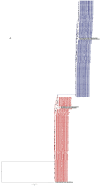Identification and Phylogenetic Characterization of Human Enteroviruses Isolated from Cases of Aseptic Meningitis in Brazil, 2013-2017
- PMID: 31362357
- PMCID: PMC6723535
- DOI: 10.3390/v11080690
Identification and Phylogenetic Characterization of Human Enteroviruses Isolated from Cases of Aseptic Meningitis in Brazil, 2013-2017
Abstract
Aseptic meningitis is a common viral infection associated with human enteroviruses. The aim of the present study was to identify and characterize the enteroviruses associated with outbreaks and sporadic cases of aseptic meningitis that occurred in different regions of Brazil between 2013 and 2017. Cerebrospinal fluids obtained from patients admitted to public health facilities were analyzed. A total of 303 patients were positive for Human Enteroviruses (EV) by cell culture isolation with a median isolation rate throughout the year of 12%. We were able to identify enterovirus serotypes in 295 clinical specimens. Nineteen different serotypes were identified; the large majority corresponded to HEV-B species. Echovirus 30 (E-30) and Echovirus 6 (E-6) were the most prevalent genotypes (66.8%). Sequence analysis suggested that circulating E-30 was closely related to E-30 from other American countries; while E-6 was derived from Europe. Most of the patients consisted of children ≤ 15 years old. The temporal distribution of all aseptic meningitis and EV-positive cases showed an obvious seasonal pattern during autumn. Our results have provided valuable information about the enteroviral etiology of the aseptic meningitis cases in Brazil pointing to the importance of enterovirus surveillance in neurological diseases.
Keywords: aseptic meningitis; echovirus-30; echovirus-6; enterovirus.
Conflict of interest statement
The authors declare no conflict of interest.
Figures






Similar articles
-
Molecular characterization of enteroviruses associated with neurological infections in Spain, 2008.J Med Virol. 2013 Nov;85(11):1975-7. doi: 10.1002/jmv.23693. Epub 2013 Jul 25. J Med Virol. 2013. PMID: 23893817
-
Molecular epidemiology of enteroviruses and predominance of echovirus 30 in an Iranian population with aseptic meningitis.J Neurovirol. 2021 Jun;27(3):444-451. doi: 10.1007/s13365-021-00973-1. Epub 2021 Mar 31. J Neurovirol. 2021. PMID: 33788142
-
Molecular typing and epidemiology of enteroviruses identified from an outbreak of aseptic meningitis in Belgium during the summer of 2000.J Med Virol. 2003 Jul;70(3):420-9. doi: 10.1002/jmv.10412. J Med Virol. 2003. PMID: 12767006
-
Enterovirus Infections of the Central Nervous System in Children: An Update.Pediatr Infect Dis J. 2016 May;35(5):567-9. doi: 10.1097/INF.0000000000001090. Pediatr Infect Dis J. 2016. PMID: 26862675 Review. No abstract available.
-
Isolation of echovirus type 13 from patients of aseptic meningitis.Jpn J Infect Dis. 2001 Dec;54(6):249-50. Jpn J Infect Dis. 2001. PMID: 11862012 Review. No abstract available.
Cited by
-
Investigating the mechanism of Echovirus 30 cell invasion.Front Microbiol. 2023 Jul 6;14:1174410. doi: 10.3389/fmicb.2023.1174410. eCollection 2023. Front Microbiol. 2023. PMID: 37485505 Free PMC article. Review.
-
First evidence of enterovirus A71 and echovirus 30 in Uruguay and genetic relationship with strains circulating in the South American region.PLoS One. 2021 Aug 12;16(8):e0255846. doi: 10.1371/journal.pone.0255846. eCollection 2021. PLoS One. 2021. PMID: 34383835 Free PMC article.
-
Detection and characterization of a coxsackievirus B2 strain associated with acute meningoencephalitis, Brazil, 2018.Rev Soc Bras Med Trop. 2020 Nov 13;54:e20190499. doi: 10.1590/0037-8682-0499-2019. eCollection 2020. Rev Soc Bras Med Trop. 2020. PMID: 33206871 Free PMC article.
-
Composition of Eukaryotic Viruses and Bacteriophages in Individuals with Acute Gastroenteritis.Viruses. 2021 Nov 25;13(12):2365. doi: 10.3390/v13122365. Viruses. 2021. PMID: 34960634 Free PMC article.
-
Molecular characterization and epidemiological aspects of non-polio enteroviruses isolated from acute flaccid paralysis in Brazil: a historical series (2005-2017).Emerg Microbes Infect. 2020 Dec;9(1):2536-2546. doi: 10.1080/22221751.2020.1850181. Emerg Microbes Infect. 2020. PMID: 33179584 Free PMC article.
References
Publication types
MeSH terms
Substances
LinkOut - more resources
Full Text Sources

